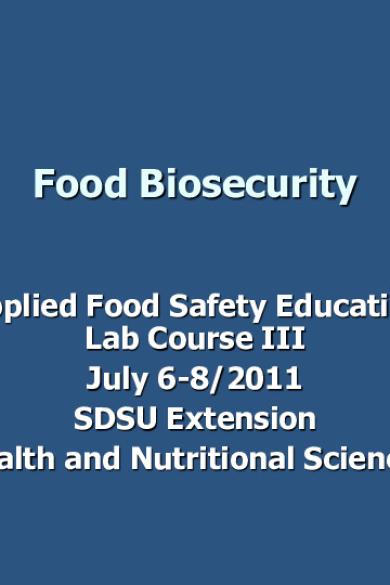* The preview only shows a few pages of manuals at random. You can get the complete content by filling out the form below.
Description
Food Biosecurity Applied Food Safety Education Lab Course III July 6-8/2011 SDSU Extension Health and Nutritional Sciences
1
Is There a Problem?
“For the life of me, I cannot understand why the terrorists have not attacked our food supply because it is so easy to do so” Secretary
Tommy Thompson-press conference announcing his resignation, December 2004
www.fns.usda.gov/fns/safety/pdf/food-defense-training
2
What is Food Biosecurity?
The term “food biosecurity” relates to the protection of food from bioterrorism. Bioterrorism is the intentional use of biological and chemical agents for the purpose of causing harm. Some government agencies are using the term “food security” instead of “food biosecurity.”
www.cals.ncsu.edu/an_sci/extension/dairy/Earhardt%20talk 3
What is Food Biosecurity?
The protection from the deliberate introduction of a dangerous substance into food. It may be perpetrated at any level in the food chain by an organized terrorist group, a lone “copy cat” individual or the result of criminal activity. Attacks are usually focused on a food commodity, process, company or business.
www.dpi.state.wi.us/fns/ppt/fd_biosecurity 4
What Foods at Risk?
Infant formula Baby food Milk Yogurt Ice cream Soft drinks Water, bottled produce
Canned food Honey Peanut butter Seafood, cooked Deli salad Fruit juices Flour
5
What Agents Might be Used?
Biological Heat resistant bacteria (e.g., Bacillus anthrax) Heat sensitive bacteria (e.g., Salmonella) Heat resistant bacteria toxins (e.g., Staphylococcus aureus toxin) Heat sensitive bacteria toxins (e.g., Clostridium botulinum neurotoxin)
6
What Agents Might be Used?
Chemical Water soluble, heat resistant chemicals (e.g., cyanide) Lipid soluble, heat resistant chemicals (e.g., dioxin) Lipid soluble, heat sensitive chemicals (e.g., ricin)
7
Terrorism Bioterrorism
Agroterrorism
Others
Biological agents targeting humans, animals, plants Bacteria Viruses Fungi Rickettsia Toxins
Biological, chemical, or radiological agents, targeting agriculture or its components Livestock Food supply Crops Industry workers
Conventional, radiological, nuclear, chemical
www.wvdhsem.gov/SERC/Conference07/SERC_07_ag%20... 8
Advantages of Biologics as Weapons
Infectious via aerosol, GI Organisms fairly stable in environment High morbidity and mortality Person-to-person transmission (e.g., smallpox) Difficult to diagnose and/or treat Attack and effect are not simultaneous, perpetrators escape easily
Inexpensive to produce Potential global effect (more and faster transportation) Creates panic Can overwhelm medical services Variety of victims: man, animal, crops
9
Biological Warfare in History Hannibal used wine containers filled with poisonous snakes against enemies Tartars hurl plaque-ridden corpses over city walls of Kaffa (what is now Ethiopia) Use of ergot to poison wells in the 6th century BC Athenians poisoning of Kirrha (590 BC)
10
Biological Warfare in History 1763: British troops infect native Americans with smallpox-laden gifts WW I German program; anthrax WW II Japanese program; anthrax, plague, cholera, shigella
11
History: Recent Examples 1969: Nixon ends BW program 1978: Ricin (castor bean) assassination in London On August 29, 1984, Indian religious Rajneeshee cultists give water laced with Salmonella to two county commissioners.
12
History: Recent Examples
In September, the Rajneeshee cult contaminates salad bars of The Dalles, OR and Wasco County, OR with Salmonella.
Over 750 are poisoned and 40 hospitalized. The purpose is to influence the outcome of a local election. It is only discovered a year later when members of the cult turned informants.
13
History: Recent Examples
1995
Aum Shinrikyo, a Japanese religious cult obsessed with the apocalypse
Released deadly Sarin nerve gas into the Tokyo subway system
Killing 12 people and sending more than 5,000 others to hospitals. Attack came at the peak of the Monday morning rush hour in one of the busiest commuter systems in the world. Witnesses said that subway entrances resembled battlefields as injured commuters lay gasping on the ground with blood gushing from their noses or mouths. http://cfrterrorism.org/groups/aumshinrikyo.html
History: Recent Examples
2001
Anthrax-laced letters sent through the mail killing 5 people.
Seventeen others developed symptoms, but recovered. Most of the cases are linked to mail passing through NJ, NY, or Washington, D.C. Estimated 10,000 people were placed on antibiotics. Attorney General John Ashcroft released the text from the anthrax letters sent to Daschle, Brokaw, and the NY Post.
For less than $5.00 in mailing costs
Our government was shut down There were 11 cases of pulmonary anthrax with 5 deaths There were 5 cases of cutaneous anthrax Thousands of people received an unnecessary 60 days of prophylactic antibiotic treatment Caused billions in response costs Caused fear and panic among the general population
History: Recent Examples
September 19, 2003 – Associated Press
Grand Rapids Michigan Former supermarket employee poisoned more than 100 people after mixing insecticide into 250 lbs. of ground beef
Health official reported 111 sickened
Sentenced to 9 years in prison
www.dpi.state.wi.us/fns/ppt/fd_biosecurity
17
History: Recent Examples
September 22, 2003 – Progressive Grocer Port
Angeles, Washington Anonymous letter sent to Safeway store threatening of tampered supermarket products FBI called in to investigate Letter submitted to state public health laboratory for bacterial contaminant testing FBI questioned store employees and beginning to fingerprint them
18
The Wisconsin Case 1996 an anonymous call about contaminated fat product added to feed Chlordane (pesticide) in rendered product supplied to large feed manufacturer and distributed to 4000 farms in four states
Milk and other products from these farms were potentially contaminated $4 million just to dispose of products
19
Supply Chain
Why Pick Agriculture as a Target? Food and fiber accounts for ~16.4% of the Gross Domestic Product (GDP) 24 million Americans are employed in some aspect of agriculture Heavily tied to other industries and sectors (transportation, food retailors, tourism, etc…)
21
Why Pick Agriculture as a Target?
Food sector a huge economic engine: $1.24 trillion/year
Food system complexity makes contamination a real risk
2,128,000 farms 30,000 food manufacturing sites (94,000 foreign) 19,000 re-packers/packers (87,000 foreign) 224,000 retail food stores 565,000 food service outlets
Ten US Ag Export Categories-2009 Soybean
16.9 (all in billions)
Meat and poultry
12.1
Corn
9.7
Other foods
8.1
Fruits and frozen juices
6.9
Animal feed
6.3
Wheat
5.5
Vegetables
4.9
Nuts
4.1
Rice
2.2
2009 Ag exports were 98.6 billion dollars In 2009, the U.S. agricultural surplus erased 13 percent of our petroleum deficit in trade. The 2009 U.S. trade surplus in agricultural goods was equivalent to 7 percent of the year's total trade deficit. Agriculture represented 1.2% of U.S. 2009 nominal GDP and employed .7% of workers (directly).
bigpictureagriculture.blogspot.com/2010/10/us 23
Overview of Bioterrorism Agents
BioterrorismThreats: Priority Biological Agents Bacterial
Anthrax Plague Tularemia Brucellosis Q fever Other
food borne pathogens waterborne pathogens
Viral
Smallpox Viral Hemorrhagic Fevers Viral Encephalitis
Toxins
Botulism Staph Enterotoxin B Ricin toxin Tricothecene mycotoxins
Bioterrorism
Category A Biological Disease: can be easily disseminated or transmitted person-to-person; cause high mortality, with potential for major public health impact; might cause public panic and social disruption; and require special action for public health preparedness.
25
Bioterrorism
These agents/diseases include:
Clostridium botulinum toxin (botulism) Yersinia pestis (the plague) Variola major (smallpox) Tularemia (Francisella tularensis) Hemorrhagic fever due to: Bacillus anthracis (anthrax)
Ebola virus Marburg virus 26
Bioterrorism
Category B Biological Disease: -Second highest priority agent include those that are moderately easy to disseminate; cause moderate morbidity and low mortality; require specific enhancements of CDC's diagnostic capacity and enhanced disease surveillance.
27
Bioterrorism
These agents/diseases include:
Q fever (Coxiella burnetii) Brucellosis (undulant fever) Glanders (Burkholderia mallei) Ricin toxin (from the castor bean Ricinus communis) Epsilon toxin of Clostridium perfringens (the gas gangrene bacillus) Staphylococcus enterotoxin B (staph toxin)
28
Bioterrorism
Category C Biological Disease: -- Third highest priority agents include emerging pathogens that could be engineered for mass dissemination in the future because of availability ease of production and dissemination; and potential for high morbidity and mortality and major health impact.
29
Food Security
Food Safety vs. Food Security The terms “food safety” and “food security” do not mean the same thing. Food security deals with deliberate contamination of food with the intent of causing harm or disruption.
30
Food Biosecurity/Safety
Food SAFETY
Unintentional
contamination of food Mild to serious illness, or even death Negative business and financial impact Biological, chemical, or physical agents Address through training
Food BIOSECURITY
Intentional
contamination of food Mild to serious illness, or even death Negative business and financial impact Biological, chemical, physical, nuclear, or radioactive agents Address through
prevention
31
Food Security
Food Safety = Quality Control
An example of unintentional contamination was the 1994 contamination of pasteurized liquid ice cream mix with Salmonella enterides. The contamination occurred in a tanker truck that transported unfrozen ice cream mix.
32
Food Security
The truck had been contaminated when carrying raw egg mix on backhaul trips. The accidental contamination caused the illness of 224,000 people in 41 states and was traced to Schwan's ice cream, a nationally distributed product.
33
Biosecurity Management
The series of management steps taken to prevent the introduction of infectious agents into a herd or flock, water or food supply. Routine Practices Involve: Screening
Testing Quarantine
or isolation of newly purchased or returning animals Monitoring or evaluation system
34
A Biosecurity Checklist for School Foodservice Programs
Keeping our Nation’s food supply safe from terrorism requires a total team effort, with participation from Federal, State, and local governments working with our country’s food and agriculture sectors.
35
A Biosecurity Checklist for School Foodservice Programs
At the Federal level, FNS will work with the Food Safety and Inspection Service (FSIS), the Food and Drug Administration (FDA), and other agencies to establish guidance for bolstering the biosecurity of food throughout its journey from farm to table-through transportation, storage, preparation, and service.
36
A Biosecurity Checklist for School Foodservice Programs 1.
2.
3.
4.
Establish a school food-service biosecurity management team Establish a checklist with the "prioritized levels" of measurements needed Add the security measures unique to each school Determine which security measures will be part of the plan
healthymeals.nal.usda.gov/hsmrs/biosecurity 38
A Biosecurity Checklist for School Foodservice Programs 5.
6. 7.
Assign tasks and develop a schedule of target dates for each task Track the progress made; and Continue to maintain and update the biosecurity plan.
39
National School Lunch Program (NSLP) NSLP serves 30 million lunches and nearly 9 million breakfasts per day Over 100,000 schools and Over 20,000 school districts participate Safety record of NSLP is very, very good, but problems do occur Protections afforded by AMS “aggregate measure of support” only go so far
www.fns.usda.gov/fns/safety/pdf/food-defense-training 40
Assemble a Team Everyone Has a Role in the Safety of Food
www.fns.usda.gov/fns/safety/pdf/food-defense-training.pdf
41
Food Security
Six agencies in the federal government have primary responsibility for food safety: two agencies under the Department of Health and Human Services (DHHS) Food and Drug Administration (FDA) Centers for Disease Control and Prevention (CDC)
42
Food Security
Three agencies under the Department of Agriculture (USDA) Food Safety and Inspection Service (FSIS) Agricultural Research Service (ARS) Cooperative State Research, Education, and Extension Service (CSREES)
Environmental Protection Agency (EPA). 43





